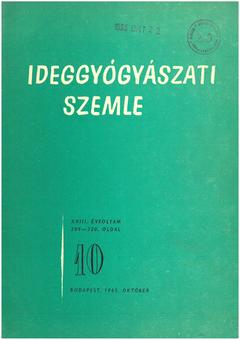The eLitMed.hu medical portal uses computer cookies for convenient operation. Detailed information can be found in the Cookie-policy.
Clinical Neuroscience - 1965;18(10)
Content
[Experimental results on the clinical use of triiodinated angiographic contrast agents ]
[Experience has shown that there have been cases where these tests have been negative and yet symptoms reminiscent of anaphylactic shock have developed. It is therefore far from being the case that a negative test is an absolute guarantee that the known symptoms and complications will not develop with the use of higher doses of the substance. In the indication for angiography, we must therefore bear in mind that this procedure, if correctly performed, does not generally involve any major risk, but we must always be prepared to deal with complications so that our patients do not fall victim to a diagnostic procedure.]
[Determination of upper limb motor fibre conduction velocity in clinical patient material ]
[The authors studied the median and ulnar conduction velocities in the forearm in 54 normal and 50 pathological cases. In a subset of cases, the mean terminal velocity (the ratio of the distance between the point of stimulation of the wrist and the recording site divided by the latent time) was determined. The distribution of the pathological cases according to the pathology was as follows : 13 peripheral nerve lesions, 4 myasthenia, 4 multiple sclerosis, 10 dystrophia musculorum progressiva, 2 polymyositis, 17 anterior horn lesions. The conduction velocity of the normal control group under 70 years of age was 58.54 +/-1.98 m/sec on the ulnaris and 57.07+1.81 m/sec on the medianus. The driving speed of the 70-80 year olds decreased significantly (P<0.05) in both ulnaris and medianus compared to the driving speed of the under 70 year olds. In peripheral nerve lesion, both conduction velocity (median : < 0.001, ulnaris : P<0.01) and mean terminal velocity (median : P<0.05, ulnaris : P<0.02) were significantly decreased. In adjacent horn processes, conduction velocity did not differ significantly from normal controls, only in amyotrophic lateral sclerosis was ulnar conduction velocity significantly decreased (P<0.05). However, the mean terminal velocity was significantly reduced in anterior horn processes (medianus : P < 0.001, ulnaris : P < 0.001). In myasthenia and multiple sclerosis, the conduction velocity did not differ significantly from the normal control group. Terminal mean velocity was not determined because no difference was expected based on the latent times measured from the wrist. In dystrophia musculorum progressiva, forearm conduction velocity did not decrease and mean terminal velocity increased compared to normal control but did not reach significance level. In polymyositis patients, the conduction velocity did not differ appreciably from normal controls. The mean terminal velocity was significantly reduced in the median (P<0.05), and the reduction in the ulnar was not significant. The differences observed in the anterior horn processes are consistent with the principle of retrograde degeneration of the neuron ("dying back"). The decrease in mean terminal velocity found in polymyositis can be explained by intramuscular nerve fiber degeneration, but this finding needs further confirmation. ]
[Our research objectives and some lessons from the psychology of fatigue]
[It reports on studies carried out over 1,1/2 decades on schoolchildren and adults to uncover the psychological phenomena that occur as a result of stress. In the case of schoolchildren, the variations in the course of the week and the periods of the day were followed, and the influence of morning and afternoon classes was examined. The circumstances that could lead to harmful overload at school and at home were determined. The studies on students and factory workers referred to particular forms of strain. The fatigue in the 3 work shifts, in different work processes and the influence of work breaks were to be clarified. The simultaneous role of attention and dexterity was tested with a self-designed device in well and poorly performing workers and in exhausted, sick individuals. Another objective was to investigate the influence of monotony. ]
1.
Clinical Neuroscience
[Headache registry in Szeged: Experiences regarding to migraine patients]2.
Clinical Neuroscience
[The new target population of stroke awareness campaign: Kindergarten students ]3.
Clinical Neuroscience
Is there any difference in mortality rates of atrial fibrillation detected before or after ischemic stroke?4.
Clinical Neuroscience
Factors influencing the level of stigma in Parkinson’s disease in western Turkey5.
Clinical Neuroscience
[The effects of demographic and clinical factors on the severity of poststroke aphasia]1.
2.
3.
4.
5.



